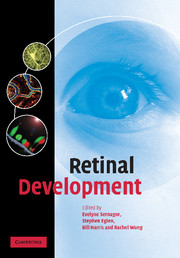Book contents
- Frontmatter
- Contents
- List of contributors
- Foreword
- Preface
- Acknowledgements
- 1 Introduction – from eye field to eyesight
- 2 Formation of the eye field
- 3 Retinal neurogenesis
- 4 Cell migration
- 5 Cell determination
- 6 Neurotransmitters and neurotrophins
- 7 Comparison of development of the primate fovea centralis with peripheral retina
- 8 Optic nerve formation
- 9 Glial cells in the developing retina
- 10 Retinal mosaics
- 11 Programmed cell death
- 12 Dendritic growth
- 13 Synaptogenesis and early neural activity
- 14 Emergence of light responses
- New perspectives
- Index
- Plate section
- References
1 - Introduction – from eye field to eyesight
Published online by Cambridge University Press: 22 August 2009
- Frontmatter
- Contents
- List of contributors
- Foreword
- Preface
- Acknowledgements
- 1 Introduction – from eye field to eyesight
- 2 Formation of the eye field
- 3 Retinal neurogenesis
- 4 Cell migration
- 5 Cell determination
- 6 Neurotransmitters and neurotrophins
- 7 Comparison of development of the primate fovea centralis with peripheral retina
- 8 Optic nerve formation
- 9 Glial cells in the developing retina
- 10 Retinal mosaics
- 11 Programmed cell death
- 12 Dendritic growth
- 13 Synaptogenesis and early neural activity
- 14 Emergence of light responses
- New perspectives
- Index
- Plate section
- References
Summary
Vision begins at the retina, a light-sensitive tissue at the back of the eye that comprises highly organized, laminated networks of nerve cells. Investigating the mechanisms of retinal development is fundamentally important to gaining a basic knowledge of how vision is established. In this book, we present the sequence of developmental events and the mechanisms involved in shaping the structure and function of the vertebrate retina.
Formation of the eye
The eye is derived from three types of tissue during embryogenesis: the neural ectoderm gives rise to the retina and the retinal pigment epithelium (RPE), the mesoderm produces the cornea and sclera, and the lens originates from the surface ectoderm (epithelium). During embryogenesis (Figure 1.1), the eyes develop as a consequence of interactions between the surface ectoderm and the optic vesicles, evaginations of the diencephalon (forebrain). These optic vesicles are connected to the developing central nervous system by a stalk that later becomes the optic nerve. When the optic vesicles contact the ectoderm, inductive events take place to cause the epithelium to form a lens placode. The lens placode then invaginates, pinches off eventually and becomes the lens. During these events, the optic vesicle folds inwards and forms a bilayered cup, the optic cup. The outer layer of the optic cup differentiates into the RPE whereas the inner layer differentiates into the retina. The iris and ciliary body develop from the peripheral edges of the retina.
- Type
- Chapter
- Information
- Retinal Development , pp. 1 - 7Publisher: Cambridge University PressPrint publication year: 2006
References
- 2
- Cited by



